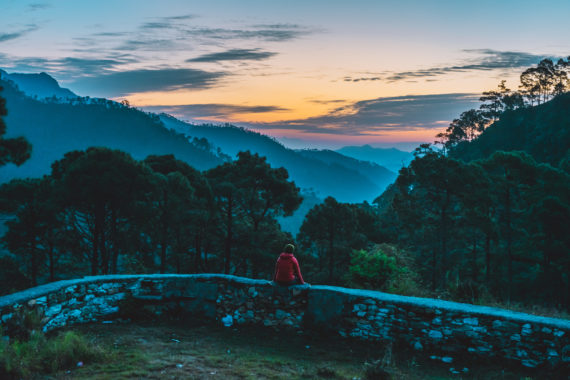
How to contemplate nature
NATURE-CENTRED MINDFULNESS is a great way to start meditation practice for a beginner, and also a beautiful practice for more experienced mindfulness and meditation practitioners.
This text extract below is taken from the upcoming book, Nordic by nature. New voices on deep ecology; Arne Naess in the 21st century. If you would like to receive a free copy of this book please sign up to the Foundation of Contemplation of Nature’s newsletter here and follow the foundation on Facebook and @foundnature on Instagram.

Preparing lemons!
The contemplation of nature for inner and outer resilience
Hi, my name is Ajay Rastogi and I live in the village of Majkhali, in the state of Uttarakhand in the Indian Himalayan region. It’s about 400 kilometres north of Delhi and we overlook the high Himalayas with many 6000-metre high peaks. I have been an ecologist and an environmentalist for a large part of my life. I used to work with the Food and Agriculture Organization of the United Nations (FAO) as the organic programme coordinator for India. The basic drive to move back was to find a tool for the transformation of people from inside, so that they can connect deeply with nature.
The fact that we are unable to make big changes in society that are needed for sustainability means that we need to look again at the approach environmental movements have taken so far. For that reason, I was thinking that meditative practice, which can be done in nature, could be transformative in making us understand that we are an integral part of the natural world. Meditation is considered as a method for inner transformation.

Ajay near the foundation’s headquarters, in the foothills of the Himalayas.
Experiential transformative learning
We have a residential programme based out of village homestays. These are typical rural homesteads, structures where there is no running water and the toilet is outside. Participants are supposed to stay for a two-week programme and help their host agrarian families, doing the same work that they do. They learn about everyday work: taking care of the cow, getting fodder from the forest, getting enough drinking water from the springs.

Students on the Mountain Resilience Leadership course learn how a mixture of cattle dung and water produces biogas for cooking stoves.
The programme is based on three pillars. One is called ‘the dignity of physical work’ because, unfortunately, we are losing the connection to working with our hands. The second is ‘interdependence’ because sometimes we feel that if we are economically sound then we don’t need anybody else – ‘I just spend money and get whatever I want’– but that’s not how society is structured, that’s not how sustainability comes about. The third thing participants learn about is ‘interconnectedness’, which is more about the landscape and the elements, where the water is coming from and so on. It is about knowing that this does not happen by itself, there are trees and filtration is taking place, there is some soil which can absorb water. It’s not as if it comes out of thin air. It needs to be nurtured.
We have a structured programme now. It’s a three-credit course, with the collaboration of Western Colorado University, called Mountain Resilience Leadership. We have also worked with the National Outdoor Leadership School for the past nine years.

A short nature-centred practice group session before co-creation workshops and meetings can change the whole dynamic and outcome of the work.
Students from all over the world come and participate in these programmes.
Bring nature to our consciousness
The nature-based mindfulness practice that we call the ‘contemplation of nature’
is done in natural surroundings, if possible. It is a multisensory experience. It helps because we are biological organisms and we have an inherent need to connect with nature. It’s kind of how we are genetically wired, so the contemplation of nature is not as abstract as many people find other meditative practices to be. It is good for beginners to feel the interconnectedness of all beings.
People can start with the contemplation of nature and then go on to learn about other deeper levels of meditation. But the contemplation of nature is definitely an approach that can be done on a daily basis. It quickly brings us to a level of tranquillity that gives us all the benefits of the meditation: the compassion, the kindness, the deeper connection to the natural law as well as to the social community around us.
At about the 23rd minute of meditation, a response known as the relaxation response activates a deeper trigger in our bodies. The relaxation response allows the body and internal chemistry to function in a much more regulated and balanced way. This also brings other benefits, including a gentle detachment from the continuous flow of thoughts and emotions, and deeper awareness and insight into our interconnected being.
Three steps for contemplating nature
So, all we do is sit and observe with a soft gaze. You can contemplate nature indoors with very simple objects from nature, following the three steps of nature contemplation that we have designed. The three simple steps of the contemplation of nature are: observe nature with a soft gaze, accept your thoughts, emotions and sensations with gentle detachment, and send love to the world with sympathetic attention.
By observing nature with a soft gaze, we bring nature into our consciousness, all the time accepting with gentle detachment our thoughts, emotions and physical sensations. We are not interested in finding details or drawing conclusions. Of course, our minds will wander here and there, but as soon as we realise this, we gently bring our mind back to simply observing nature with a soft gaze.
One very important element of any meditation practice is to let go of your thoughts. You do not do this by fighting them but just by observing them and acknowledging them without judgement. This is what sympathetic attention means. Be gentle with yourself and just remind yourself of feelings of gratitude and oneness with nature. We sit, we observe softly with a gentle gaze, and continue sitting with gentle detachment. No matter what thoughts come to mind, don’t make any judgment about where you are, or what you are doing or thinking. It is this step that is transcendental in nature, and therefore a fundamental aspect of the practice. Being able to sit quietly allows us to somehow transcend a call of judgment and ‘the thinking mind’, at least for a little while.
.
.
.
